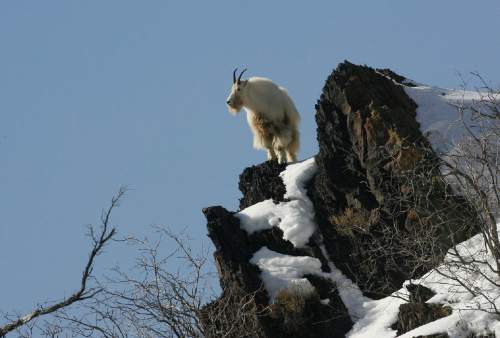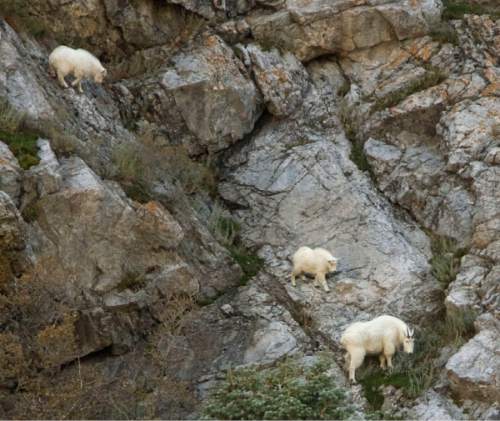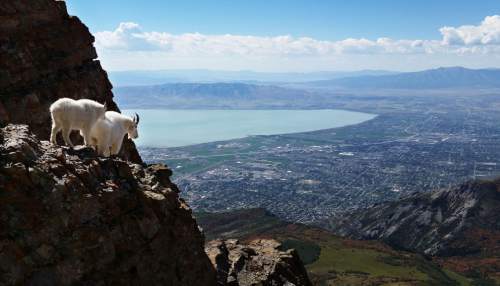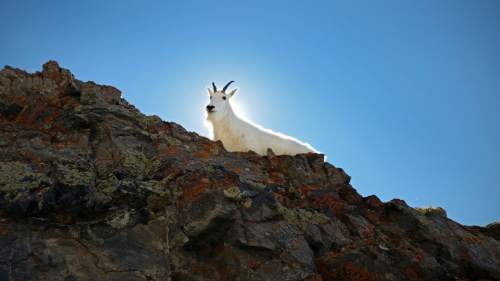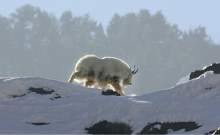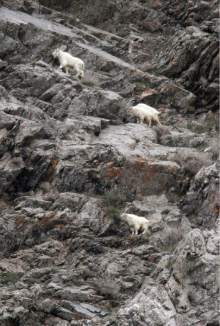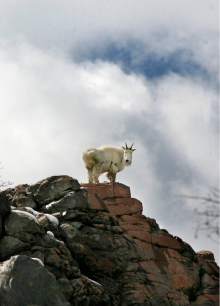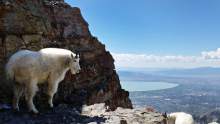This is an archived article that was published on sltrib.com in 2016, and information in the article may be outdated. It is provided only for personal research purposes and may not be reprinted.
Utah's first mountain-goat herd was established on Lone Peak nearly a half century ago with the translocation of six animals that soon swelled to more than 100, enough to support hunting by 1981 and other goat translocations around Utah.
But today, goats have become increasingly rare on Lone Peak, the jagged crest looming above Draper, and the next two big Wasatch peaks to the south, Box Elder and Timpanogos, and state wildlife officials want to find out why.
To do so, the Utah Division of Wildlife Resources proposes to use helicopters to capture and collar 30 goats.
"We will monitor their movements and survival and identify limiting factors. We will see if it's a disease, predation or habitat issue," said DWR biologist Rusty Robinson.
"There are a lot of things we don't know about mountain-goat disease. If that's the cause of this decline, there are things we can learn from this."
Because these peaks are in wilderness areas, the project requires special permission from the U.S. Forest Service, which has launched an Environmental Assessment for public comment, even though ground impacts would be negligible. The Uinta-Wasatch-Cache National Forest is fielding comments through Friday.
Some environmental groups oppose the project because mechanical equipment, including helicopters, chainsaws and mountain bikes, is not permitted in designated wilderness.
"We don't understand the need to violate the wilderness to study an invasive species," said Carl Fisher of Save Our Canyons. Many conservationists argue that mountain goats shouldn't even be in the Wasatch Mountains.
"How will management of mountain goats for the purposes of hunting and viewing help the Forest Service administer the Twin Peaks, Lone Peak and Mount Timpanogos wildernesses so as to preserve or enhance their wilderness characteristics?" wrote a consortium of Utah groups, including Save Our Canyons and Wild Utah Project, to Salt Lake District Ranger Rebecca Hotze last week.
The Rocky Mountain goat is a native of the Northern Rockies, but its range has been artificially expanded south, thanks to translocations at the behest of sportsmen who enjoy going after big game. While it not clear whether goats are native to Utah, state policy calls for establishing herds on all Utah mountain ranges with habitat that can sustain these animals.
But on Lone Peak, where the translocation experiment began, goat numbers have plummeted. In 2004, 165 goats inhabited this unit, but only 27 were estimated in the 2014 survey, according to DWR's annual big game reports. On Box Elder Peak, goat numbers dropped from 50 to 34 and on Mount Timpanogos they dropped from 109 to 76.
According to Robinson, DWR periodically counts goats by air and bases population estimates on the assumption that 80 percent of a herd was observed.
Since 1999, the goat population of the entire Wasatch Range has dropped from 500 to 200, while elsewhere, goat numbers have boomed, particularly on the Tushars and Willard Peak, which have been tapped to establish and augment herds elsewhere.
And a few years ago, a goat wandered out of the Uintas and took up residence in Dinosaur National Monument. Because goats are not native to that terrain, the National Park Service developed a plan calling for the lethal removal of mountain goats.
While 2012 may have been a troubling year for goats in the central Wasatch Mountains, their numbers around the state reached about 2,000 and a record 175 hunting permits were issued that year. For this fall's hunt, 97 permits will be issued, including four for the units subjected to the monitoring plan.
DWR hopes to collar 20 goats this fall, and another 10 next fall. Each operation would require up to eight flight days into Mount Timpanogos, Lone Peak and Twin Peak wilderness areas, whose boundaries do not correspond exactly with hunting units. According to Robinson, 92 percent of the goats counted in aerial surveys are seen in designated wilderness.
For the study, chopper-borne crews would net animals one at a time from the air. The helicopter would touch down for the researchers to exit and process each goat, which would be hobbled and blindfolded while blood samples are taken, data recorded and radio collars installed around their necks.
"It's not very invasive," Robinson said.
Should a collared animal die, researchers would know immediately where to find the carcass, but retrieving it may still be difficult.
"You have a limited windows to figure out why that animal died. You can imaging the terrain up there," Robinson said.
Twitter: @brianmaffly


